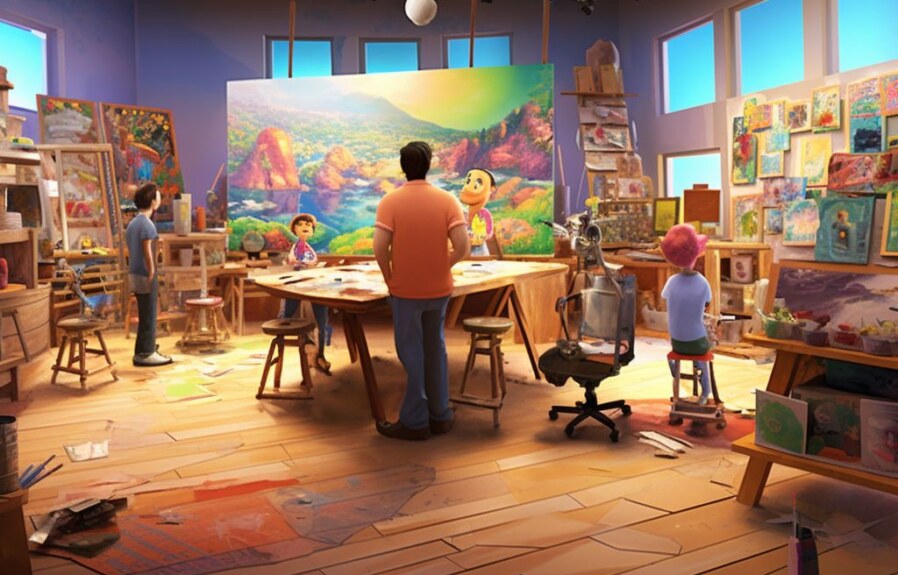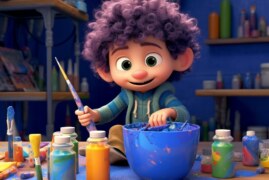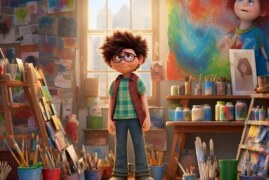The world of anime is fascinating and alluring, with its vibrant colors, unique character designs, and captivating storylines. For those who love anime, the idea of being able to draw their favorite characters is a dream come true. Whether you’re a beginner or an experienced artist, learning how to draw anime characters can be a rewarding and enjoyable experience. In this article, we’ll show you the tips and techniques you need to create stunning drawings of your favorite anime characters. Get ready to unleash your creativity and explore the world of anime art!
1. Understanding the Basics: Tips and Tricks for Anime Character Sketching
When it comes to anime character sketching, understanding the basics is crucial to creating an appealing and expressive character design. Here are some tips and tricks to keep in mind as you work on your sketches:
– Practice drawing basic shapes: Before diving into character design, practice drawing basic shapes and getting comfortable with your drawing tools. This will help you develop a sense of control and precision when sketching.
– Pay attention to proportions: Anime characters often have exaggerated features, but maintaining good proportions is still important. Take note of the size and placement of the head, eyes, nose, and mouth. Make sure that the body and limbs are appropriately sized in relation to the head.
– Add personality through expression: The expression on a character’s face can convey a lot of personality and emotion. Experiment with different expressions and see how they change the overall feel of the character.
– Use references: Don’t be afraid to use reference images for inspiration and guidance. Look at how other artists have approached anime character design and try to incorporate techniques that you like into your own work.
– Practice, practice, practice: Like any skill, anime character sketching takes practice to improve. Keep at it, experiment with different styles, and don’t be too hard on yourself if the results aren’t perfect right away.
2. From Pencils to Paint: Tools and Resources for Perfecting your Anime Art
For those looking to improve their anime art, having the right tools and resources can make all the difference. From pencils to paint and everything in between, here are some items to consider adding to your toolkit:
– Quality Pens and Pencils: A good set of pencils and pens can help you achieve the level of detail necessary for great anime art. Look for brands such as Copic, Staedtler, or Sakura to ensure that you are working with high-quality tools that will produce lasting work.
– Digital Tablet: If you prefer working digitally, a tablet can be a valuable resource for creating anime art. Brands such as Wacom offer tablets that allow for excellent pressure sensitivity and customizable buttons, allowing you to work more efficiently and achieve more precise lines.
– Sketchbook: Aspiring anime artists should always have a sketchbook on hand for practice and brainstorming. A good sketchbook can also be used to refine ideas and work out details before moving on to final artwork.
– Online Resources: The internet is a wealth of knowledge when it comes to perfecting your anime art. Websites such as DeviantArt or Pixiv are great for finding inspiration and connecting with other artists. YouTube tutorials can also be a useful resource for learning new techniques or troubleshooting common problems.
Investing in quality tools and resources can help you reach your full potential as an anime artist. Whether you prefer traditional mediums or digital tools, the right equipment and resources can make all the difference in achieving great results.
3. Mastering Anatomy: Key Elements to Consider When Drawing Anime Characters
Proportions
When drawing anime characters, it’s essential to get the proportions right. If you’re not confident with this, consider using references such as models or photos before trying to draw from memory. You may also want to start with basic shapes like circles, triangles, and rectangles to help you get the ratios and positions correct.
Key points to remember:
- The head is often larger than in real-life proportions, and the body tends to be thinner and taller.
- The eyes are typically oversized, taking up a significant portion of the face.
- The hands and feet are often smaller than in real life.
Pose and Gesture
Anime characters often have dynamic and exaggerated poses to emphasize their personalities or emotions. When drawing characters, consider their expressions, movements, and body language. It’s also essential to focus on gesture- the flow of the character’s movements- which adds an additional level of expressiveness to your drawings.
Key points to remember:
- Start with simple shapes to sketch out the pose or action before adding details.
- Use reference images or videos to study movement and posture.
- Consider the character’s personality and emotions and how it would affect their pose and gestures.
4. Capturing Emotion: Techniques for Expressive Faces and Body Language
Facial expressions and body language are powerful tools for conveying emotion in storytelling, whether it’s for film, photography, or theater. However, capturing these nuances can sometimes be challenging. Here are some techniques to help you express emotion effectively through faces and body language:
1. Pay attention to micro-expressions. Sometimes, the tiniest shifts in facial muscles can communicate a lot more than big, exaggerated expressions. Look for subtle movements around the eyes, mouth, and forehead, and try to capture these in your shots or performances.
2. Use the body as a whole to communicate emotion. Body language isn’t just about the face – the whole body can express emotion in different ways. For example, if someone is feeling fearful, they might hunch their shoulders, draw their arms inwards, and make themselves smaller. If they’re feeling confident, they might stand tall, with their chest puffed out and their head held high.
3. Practice, practice, practice. Like any other skill, capturing emotion through facial expressions and body language takes practice. Spend time observing people in different situations, and try to identify the specific physical cues that communicate their emotions. Then, experiment with different ways of capturing these cues in your own work. With time, you’ll develop a sharper eye for emotional expression, and be able to convey it more effectively.
5. Bringing it to Life: Coloring and Shading Techniques for a Professional Finish
Once you have outlined and sketched your artwork, you’ll be ready to bring it to life with coloring and shading techniques for a professional finish. Here are some tips to help you achieve the perfect look for your illustrations and designs:
1. Choose Your Colors Wisely: When selecting colors, consider the mood you want to convey. Use vibrant, warm colors for energetic and lively images, while lighter shades can give a more gentle or innocent feel. Dark or muted colors, on the other hand, can give a more serious or mysterious look.
2. Use Layers: Create multiple layers for each color in your design. This will allow you to adjust the opacity, blend mode, and saturation of each color individually to create depth and shadow in your artwork. Layering also makes it easier to make changes or incorporate new elements into your design without affecting the entire piece.
3. Practice Your Shading Techniques: Whether you prefer cel shading or more realistic shading, the key to achieving a professional look is consistency. Practice your technique until you can reproduce the same shading over and over again with precision. Use gradients, light sources, highlights, and shadows to create a three-dimensional effect, and adjust the opacity of your shading layers to give a sense of depth.
4. Don’t Overdo It: Remember that less is more when it comes to coloring and shading. Overzealous shading can ruin an otherwise great illustration, so take a step back and review your work regularly to ensure you’re not getting carried away. Finally, use your personal judgment and preference to decide when your artwork is ready for display.
By implementing these simple tips, you can enhance the visual appeal and professional look of your artwork, designs or illustrations. Experiment with color schemes, layering, and shading techniques to find the perfect fit for your style and skill level.
6. Practicing with Purpose: Effective Ways to Improve Your Anime Drawing Skills
1. Study References
One of the best ways to improve your anime drawing skills is to study references. Look for inspiration in manga or watch anime shows to see how characters are drawn. Take note of character designs, movement, and perspective. It’s essential to observe how anime artists use shapes, lines, and color to create depth and dynamics in their artwork.
Try to reproduce these designs, and then create your original artwork based on what you’ve learned. This process will help you develop your style and help you create more complex drawings with ease.
2. Master the Basics
Before you start creating complex anime designs, mastering the basics is essential. Practice drawing basic shapes, and lines to understand how every component interacts with each other. Once you’ve done that, experiment with shading and proportion. You can even use reference images to guide you on how to execute these techniques correctly.
With consistent practice, you’ll be able to create even more detailed anime drawings that showcase your skill set better.
3. Continual Practice
The key to improving your anime drawing skills is practice. Practice allows you to refine and improve your techniques over time. Set up a regular drawing routine and challenge yourself every day to improve your skill set. Also, try to experiment with different styles or media to push your comfort zone and build new skills. Finally, ask for feedback and critiques from peers and art teachers. They can help you spot problems in your drawings and provide suggestions to help you improve.
7. Embracing Your Style: Tips for Infusing your Own Creativity into Anime Art
One of the most exciting things about anime art is the endless possibilities for creativity. Whether you love traditional anime styles or prefer to create your own unique spin, there are plenty of ways to infuse your own personal style into your art. Here are some tips for embracing your style and making your anime art truly your own:
1. Experiment with different styles: Don’t be afraid to try out different anime styles and techniques to find what works for you. Whether you’re into chibi characters, detailed backgrounds, or action-packed scenes, there’s a style out there that will help you bring your vision to life.
2. Use your own color palette: While traditional anime art tends to rely on a specific set of colors, you can infuse your own style by playing with different color schemes. Think about the mood you want to convey in your art and experiment with different hues and shades to create a unique look.
3. Incorporate your own interests: One of the best ways to make your anime art stand out is to incorporate your own interests and passions. Whether it’s a love for nature, sports, or music, bring these elements into your art to create a style that feels truly your own.
People Also Ask
What is anime?
Anime is a style of Japanese animation that often features colorful graphics, vibrant characters, and fantastical themes.
What are the basic steps to draw an anime character?
Some basic steps to draw anime characters include drawing the head and facial features, sketching the body, adding clothing and details, and shading and coloring the final product.
What materials do I need to draw anime characters?
To draw anime characters, you can use materials such as pencils or pens, sketch pads, rulers or straightedges, and color mediums like colored pencils, markers, or digital tools.
How do I improve my anime drawing skills?
You can improve your anime drawing skills by practicing frequently, studying the work of other artists, learning anatomy and proportions, experimenting with different techniques, and seeking feedback from others.
Who are some famous anime artists?
Some famous anime artists include Hayao Miyazaki, Akira Toriyama, Masashi Kishimoto, Osamu Tezuka, and Rumiko Takahashi.
Final Words
Drawing anime characters can be a fun and rewarding hobby, but it takes time and practice to develop your skills. By following some basic steps and experimenting with different techniques, you can create unique and expressive artwork that captures the essence of this popular art form. Remember to have fun, be patient, and keep practicing to improve your anime drawing skills.



